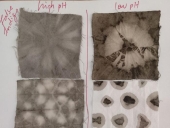Over the past two months I have discovered that it's entirely possible to ret yucca leaves in a tank of water like flax. The process takes considerably longer than it would take with flax, but it does in fact work. For this process, I submerged the bundles of yucca leaves in a wheelbarrow filled with water and changed the water daily over a period of three months. Every week, I would test the yucca leaves to see if the outer skin of the leaves would peel off with my bare fingers and then I would gradually remove the leaves that had completely peeled away the outer skin. After about a month and a half to two months into the process, the retting started to slow down and I had to scrape off the remaining skin from the leaves with a mussel shell and a very smooth cutting board. After scraping off the skin from the remaining leaves, I then pounded the leaves with the flat side of a kitchen mallet against the smooth cutting board to separate the fibers. Once these remaining leaves were pounded, I let them dry for a day and a half and bundled them with the other leaves.
In order to separate the fibers even further, I bought a set of flax hackles from Wingham Woolworks and passed the processed and dried leaves through the hackles to open up the fibers and separate the tow from the line fibers in the leaves. I got a surprisingly high yield of line fiber using this method and most of the fiber was usable for distaff spinning, including the longer tow fibers resulting from as second and third hackling of the leftover tow fiber. The resulting fibers have a coarse texture that's somewhere between hoarse hair and medium grade wool. I'm hoping I can soften any cloth I weave from the fibers by washing it in hot water with borax and washing soda so I can use the yucca fiber to weave outer clothing.
Because I processed almost an entire fully mature plant, I got a yield of 8.5 ounces of fiber. One of my neighbors was remodeling a house. This remodeling included completely redoing the landscaping so he let me harvest the entire yucca plant.
Given how long this retting process took, I'm debating on whether or not to use it the next time I prepare yucca fiber for spinning. It's very efficient at separating the leaf pulp and skin from the leaf fibers, but it generates foul smelling gas and tends to attract mosquitos even when the water is changed daily.











